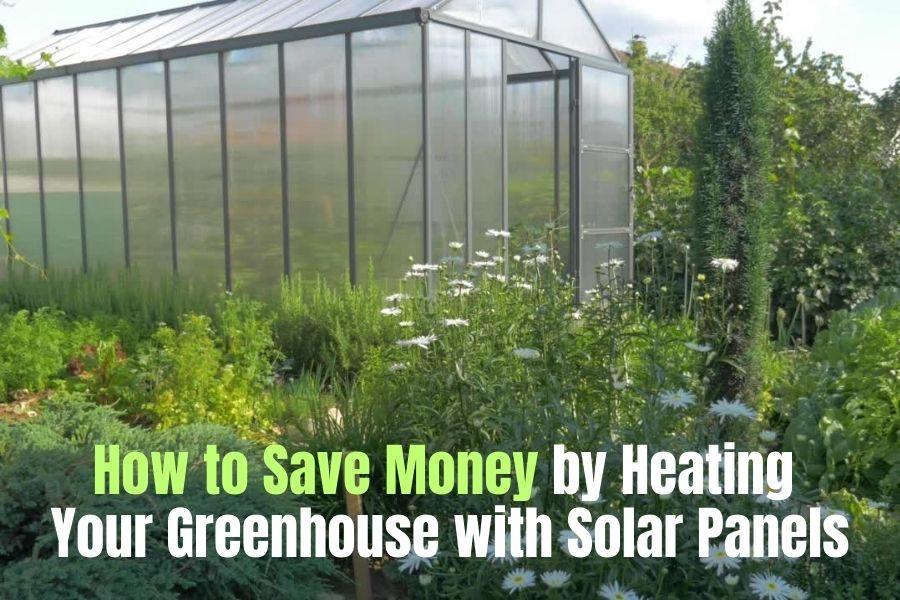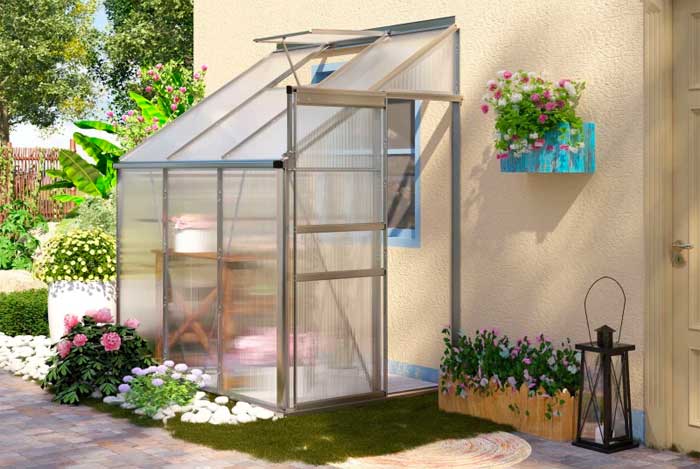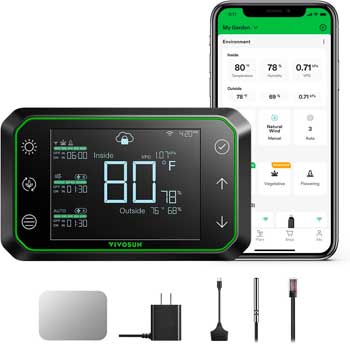Let’s talk solar panels, shall we? They’re like your greenhouse’s sun-bathing buddies. They soak up sunbeams, turn ’em into heat, and voilà—your plants are in paradise. Money-saving and green-thumb-approved.

How Do Solar Panels Heat a Greenhouse?
Solar panels work like sun-powered magic wands. They absorb sunlight and convert it into electricity. This energy can run heating systems, warming the greenhouse to cozy levels. Think of it as a sustainable suntan for your plants!
Use temperature and humidity sensors and automated systems to monitor/control your greenhouse temperature effectively. Smart greenhouse controllers also come in handy.
Also see: How to Regulate Greenhouse Temperature.
By integrating these products into your small greenhouse, you can create a comprehensive and effective temperature monitoring and control system. This not only ensures your plants thrive but also simplifies greenhouse management.
What are the Best Solar Panels for Greenhouse Heating?
What’s the most popular choice when it comes generating solar energy? Photovoltaic panels for greenhouse heating.
Photovoltaic Panel Advantages:
Solar panels are a great idea for heating greenhouses, whether on a commercial farm or in a backyard. They turn sunlight into electricity, powering heaters for steady warmth. Easy to install and fitting different greenhouse sizes, they’re the top choice for eco-friendly heating.
Drawbacks to Solar Panels:
Using solar panels for greenhouse heating has downsides. Initial costs can be high, and they depend on sunlight exposure, working less on cloudy days or at night. Area needed and environmental impact are also factors.
Even with challenges, improving technology and lower manufacturing costs are making solar panels more popular for greenhouse heating.
What are the Benefits of Heating a Greenhouse with Solar?
First, you save money, reduce carbon footprints and gain year-round growing power. Plus, solar-powered heating solutions for greenhouses are ultra low maintenance.
How Much Money Can You Save? Solar cost savings depends various factors, including your location, the efficiency of your solar heating system, the local climate and the cost of alternative heating methods. Additionally, local incentives, rebates and tax credits for solar installations can increase your overall savings.
Are Solar-Heated Greenhouses Cost Effective in Colder Climates?
Yes, even in regions with harsh winters, solar panels can be highly effective. With proper insulation and a backup heating system in place, it’s possible to maintain a warm and productive greenhouse environment
Note: Moreover, a backup heating system ensures that even during extreme cold snaps or nighttime, the greenhouse’s temperature remains within an optimal range for plant growth. This combination of solar heating, insulation and backup heating allows for year-round cultivation.

For example, in the Netherlands, where winters can be chilly, advanced solar-heated greenhouse technology has been employed to cultivate crops successfully. These greenhouses utilize solar power along with effective insulation to mitigate the cold.
In Alberta, Canada, where cold winters are common, solar heating has been embraced to extend the growing season. By carefully planning and implementing solar heating systems, growers can produce fresh vegetables and fruits during the colder months.
Can You Use Solar-Heated Greenhouses for Year-Round Crop Production? Absolutely, if you plan well. Combining solar heating with proper insulation and lighting can turn your greenhouse into a 365-day salad bar.
What Types of Solar Heating Systems Work Best for Greenhouses?
Think solar air heaters, radiant floor heating and solar water heating systems. Each has its own charm, depending on your greenhouse’s needs. Here are specific examples of solar heating systems commonly used in greenhouses, along with their advantages:
1. Solar Air Heaters:
- Example: SolarWall by Conserval Engineering.
- Advantages: Solar air heaters use sunlight to heat and circulate air into your plant nursery. They effectively extend the growing season during colder months. SolarWall, for instance, can provide consistent heat without additional equipment or complex installations.
- Disadvantages: Using solar air heaters to warm a greenhouse has some drawbacks. Firstly, they may struggle during cloudy days or at night when sunlight is limited. Additionally, their efficiency can be influenced by factors like the greenhouse size and local climate conditions. It’s crucial to consider these limitations when relying solely on solar air heaters for greenhouse heating.
2. Radiant Floor Heating:
- Example: Warmboard-R.
- Advantages: Radiant heating, like Warmboard-R, involve embedding a network of tubing under the greenhouse floor. Heated water circulates through these tubes, radiating warmth upward. This method is excellent for holding an even interior temperature, promoting root health and preventing frost. It’s ideal for year-round cultivation.
- Disadvantages: Radiant floor heating for a greenhouse has drawbacks. It may be expensive to install initially, and repairing the system can be challenging. Additionally, it might not be as efficient in extremely large greenhouses, necessitating supplementary heating sources. Consider these factors before opting for radiant floor heating in your greenhouse.
3. Solar Water Heating Systems:
- Example: SunEarth Empire SHW Series.
- Advantages: Alternatively, you can use sun power to warm up the water and get it to all of your plants for space heating or used to warm soil beds. They are versatile and can be customized to fit greenhouse size and specific requirements. The SunEarth Empire offers efficient solar thermal collectors for water heating applications.
- Disadvantages: Using a solar water heating system for greenhouse warmth has its downsides. Cloudy days can reduce efficiency, and initial installation costs may be high. Maintenance complexities and potential system failures also pose challenges. Evaluate these factors before relying solely on a solar water heating system in your greenhouse.

Each heating option carries its own advantages, and the choice depends on greenhouse size, climate, budget and intended use. For instance, if you have a smaller seasonal greenhouse, a solar air heater might be cost-effective and easy to install.
On the flip side, a larger, year-round greenhouse might benefit from radiant floor heating to maintain consistent temperatures. Alternatively, solar water heaters offer more versatility.
Are There Government Incentives for Solar Greenhouse Installations?
Many governments offer incentives for solar greenhouse installations as part of their commitment to sustainable practices. These incentives often include tax credits, rebates, and grants, designed to encourage more individuals and businesses to integrate green technology into their operations.
By taking advantage of these incentives, you’re essentially receiving a financial bonus for making environmentally responsible choices. It’s advisable to check with local government agencies or dedicated sustainability offices to understand the specific incentives available in your area.
This way, you can maximize the benefits while contributing to the broader goal of reducing carbon footprints and promoting renewable energy sources in agriculture.
What Challenges/Limitations Come with Solar for Greenhouse Heating?
I recognize that while using solar energy to heat greenhouses offers numerous benefits, it also comes with specific challenges and limitations that must be addressed. The primary limitation is the dependency on sunlight. Solar energy systems are less effective on cloudy days and cannot generate heat at night, which can be particularly problematic during the winter months when sunlight is less abundant and heating demands are higher.
To mitigate these challenges, it is crucial to have backup heating systems in place. These can include traditional heating systems powered by gas or electricity, or alternative renewable options like biomass heating systems. Additionally, incorporating high-quality insulation into your greenhouse design is essential. Proper insulation helps retain heat during the night and on cloudy days, reducing the overall energy required to maintain optimal temperatures.
Another consideration is the initial cost and space requirements for installing solar panels. These factors can be significant, especially for larger operations. Planning for adequate space and budgeting for the upfront investment are important steps in integrating solar heating into a greenhouse.
Overall, while solar energy provides a sustainable and cost-effective solution for greenhouse heating, it necessitates careful planning and the implementation of complementary systems to ensure that the greenhouse environment remains stable and conducive to plant growth regardless of solar availability.
Note: Orientation is key! South-facing greenhouses catch more rays. It’s like placing your greenhouse on the sunny side of the street. For example, a lean-to greenhouse design attached to a south-facing wall is like a solar magnet. It’s efficient and space-saving.

What Maintenance Do Solar Panels Require?
Using solar panels to heat a greenhouse is an incredibly efficient and low-maintenance solution. The primary maintenance task for solar panels is simply keeping them clean. Dirt, debris, and leaves can reduce their efficiency, so periodic cleaning is necessary to ensure maximum energy capture. It’s also important to inspect the panels occasionally for any physical damage or wear that could impact their performance.
Aside from these straightforward maintenance needs, solar panels are quite robust and require little intervention. This low-maintenance aspect makes solar panels an ideal choice for heating greenhouses.
They provide a sustainable, cost-effective heat source that, once installed, offers a reliable and environmentally friendly way to maintain optimal growing conditions for plants. Adopting solar heating in a greenhouse not only reduces energy costs but also aligns with green practices, making it a wise decision for any greenhouse operator looking to enhance sustainability.
4 More Ways to Lower Your Greenhouse Cost without Electricity:
It’s entirely possible to catapult your greenhouse into the future with solar panels. In fact, it’s a no-brainer for savvy horticulturists! Here are 4 more ways that you can take advantage of the power of solar for your backyard plant nursery…
1. Solar-Powered Ventilation: Give your plants a breath of fresh air with solar-powered fans. Say goodbye to sweltering summers and icy winters. Take control!
2. Let There Be Solar Light: Illuminate your greenhouse with solar-powered LEDs. Your plants will thank you with lush, vibrant growth. Shine on!
3. Watering the Smart Way: Solar pumps and irrigation systems ensure your plants stay hydrated without draining your wallet. Efficiency, thy name is solar.
4. Power Storage Superhero: Stash away extra solar energy in batteries. Cloudy days? Nighttime? Not a problem. You’re always in charge.
Summary:
In conclusion, harnessing the power of solar panels to heat a greenhouse is not just an environmentally friendly choice but also a savvy one. Horticulturists can reduce costs while also enhancing year-round cultivation.
By utilizing solar air heaters, radiant floor heating or solar water heating systems, greenhouse operators can create a sustainable and efficient temperature control system. The integration of smart greenhouse controllers further streamlines the process. As a result, it ensures optimal conditions for plant growth.
Governments’ support through incentives adds another layer of encouragement. Thus, they make solar-powered greenhouses a feasible and economically sound investment.
In essence, passive solar heating for greenhouses emerges as a compelling solution. It’s cost-effective and eco-conscious year-round crop production.
Last Updated May 4, 2024




 Flexible Solar Panels
Flexible Solar Panels
